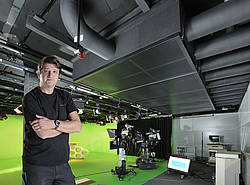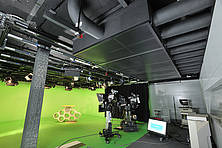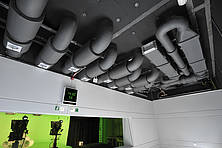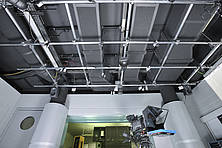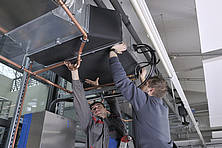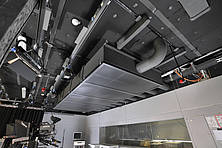Münster, 12 March 2014 – It is almost as old as the Federal Republic of Germany: Deutsche Welle was founded as Germany's foreign broadcast service over 60 years ago and has been serving listeners around the world ever since. In 1965, the broadcaster started a television channel, and in 1994 it was Germany's first public broadcast service to go online. The broadcaster employs around 1,500 permanent staff and about the same number of freelancers at its headquarters in Bonn and its Berlin location.
Renovation of radio and television studios
In 2012, the broadcaster underwent the most significant reforms in its history. The cost savings made required the reduction of capacity in radio broadcasting and a consolidation of television and internet services. The reforms involved creating television capacity in Bonn and the conversion of radio studios into television studios. Over an eight-month construction period, one of Germany's most up-to-date compact studios was constructed in the former Schürmannbau, Deutsche Welle’s Bonn headquarters. Three million euros were invested in the 100 m² studio, which is equipped with a huge LED wall, a grass-green floor, and an arsenal of lights and cameras.
Along with interior design, room acoustics were a decisive factor in the construction process. The Leverkusen-based insulation company Vrljic has been the preferred insulation contractor for Deutsche Welle for many years and relies exclusively on insulation materials from Armacell in the construction and maintenance of technical facilities. Last year alone, the company used almost 2,000 m² of AF/ArmaFlex tubes (AF-3, 12.5 to 19 mm) and about 2,000 m² of 19 mm thick AF/ArmaFlex sheet material (both the standard and self-adhesive varieties) in insulating layers for a number of different applications. When insulating the ventilation ducts of the new TV studios, noise reduction was even more important than the thermal insulation.
Elimination of unwanted extraneous noise using ArmaSound RD
Ventilation ducts supply the studio with fresh air and maintain a comfortable temperature. However, they can also carry unwanted noise into the building – the sound of fans or other parts of the ventilation system, noise caused by air flow, and even voices from neighbouring rooms. Of course, such unwanted noise must be kept out of the new TV studio so that it does not reduce the sound quality of broadcasts. Ivica Vrljic therefore decided to insulate the studio's incoming and outgoing air ducts, and the pressurized ceilings that reduce air speed, with ArmaSound RD 240. The acoustic insulation material from Armacell has outstanding noise absorption qualities across a broad range of frequencies. The required level of sound absorption can be achieved with thinner layers of ArmaSound RD than with traditional insulation materials. The relatively high density and high flow resistance of the material offers an effective barrier to sound. A further advantage of the material is that its viscoelastic properties dampen resonance effects and so reduce re-radiation effects. Around 500 m² of ArmaSound RD 240 with thicknesses of 20 mm and 25 mm was installed on parts of the ventilation system by Vrljic's employees.
Simple and neat installation
Managing Director Ivica Vrljic: “The client, my employees, and I were very happy with the installation. ArmaSound is dust and fibre free and is just as flexible as ArmaFlex. It’s easy to cut and install. The result can be both seen and heard.”
The insulation materials were supplied by Raab Karcher's Düsseldorf branch.
Deutsche Welle's employees started broadcasting from the new, state-of-the-art television studio at the beginning of the year – without any noise disturbance from the ventilation system.
